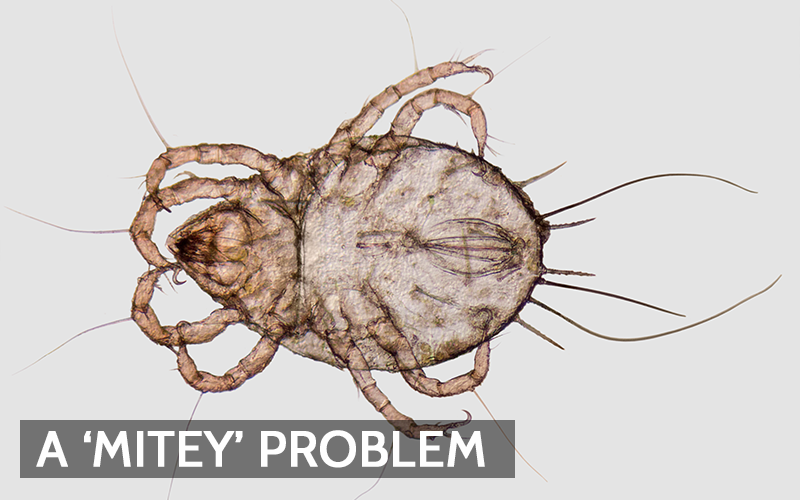Dust mites are microscopic arachnids, closely related to ticks and spiders, that thrive in indoor environments. Measuring approximately 0.2–0.3 millimeters in length, they are invisible to the naked eye. These mites feed on dead human skin cells, which are abundant in household dust, making homes an ideal habitat for them to multiply in1.
How Dust Mites Enter and Thrive in Homes
Dust mites naturally inhabit environments where human skin cells accumulate. They are commonly found in bedding, upholstered furniture, carpets, and curtains—areas that provide both a food source and favorable living conditions. These mites thrive in warm, humid environments, with optimal growth occurring at temperatures between 68–77°F (20–25°C) and humidity levels above 50%2.
Health Implications of Dust Mite Exposure
While dust mites themselves do not bite or transmit diseases, their presence can lead to significant health issues, especially for individuals with allergies or asthma. The primary concern arises from proteins found in dust mite feces and decomposed bodies, which are potent allergens. Inhaling these allergens can trigger allergic reactions, including sneezing, runny nose, itchy or watery eyes, nasal congestion, and coughing. For those with asthma, exposure may exacerbate symptoms, leading to increased wheezing, chest tightness, and shortness of breath. Chronic exposure to dust mite allergens has been linked to the development and worsening of asthma, particularly in children1.
Managing Dust Mite Populations in the Home
Completely eradicating dust mites from the home is neither practical nor necessary. Instead, the focus should be on controlling their population to minimize health risks. Effective strategies include:
- Maintain Low Humidity Levels: Since dust mites thrive in humid conditions, keeping indoor humidity below 50% can significantly reduce their numbers. Utilizing dehumidifiers and air conditioners can help achieve and maintain these levels2.
- Regular Cleaning of Bedding and Upholstery: Wash bed linens, pillowcases, and blankets weekly in hot water (at least 130°F or 54°C) to eliminate dust mites. Encase mattresses and pillows in allergen-proof covers to create a barrier against mites1.
- Vacuuming with HEPA Filters: Use vacuums equipped with high-efficiency particulate air (HEPA) filters to effectively capture dust mites and their allergens from carpets, rugs, and upholstery. Vacuuming should be done at least twice a week, with particular attention to high-traffic areas3.
- Reduce Clutter: Cluttered areas can accumulate dust, providing more habitats for dust mites. Keeping the home organized and minimizing unnecessary items can reduce dust accumulation4.
- Choose Appropriate Flooring: Hard flooring surfaces like wood, tile, or linoleum are less hospitable to dust mites compared to carpets. If carpets are preferred, opt for low-pile options and ensure they are cleaned regularly4.
- Control Indoor Temperature: Maintaining a cooler indoor temperature can inhibit dust mite growth. Aim to keep the home temperature below 70°F (21°C) when possible2.
- Use Air Purifiers: Air purifiers with HEPA filters can help remove airborne dust mite allergens, improving indoor air quality. However, they should complement, not replace, regular cleaning practices2.
- Regularly Clean Curtains and Soft Furnishings: Wash curtains and clean upholstered furniture regularly to reduce dust mite habitats. Consider replacing heavy drapes with washable blinds or shades4.
- Limit Indoor Humidity Sources: Activities like drying clothes indoors or using humidifiers can increase indoor humidity. Whenever possible, dry clothes outside or in a well-ventilated area and monitor the use of humidifiers to prevent creating favorable conditions for dust mites2.
Dust mites are an inevitable part of the indoor environment, but their population can be effectively managed through diligent household practices. By maintaining low humidity levels, regularly cleaning bedding and upholstery, and reducing dust accumulation, homeowners can minimize exposure to dust mite allergens and mitigate associated health risks. Implementing these strategies not only improves indoor air quality but also contributes to a healthier living space for all occupants.
Related Articles:
Mold Growth Surges in the Fall, Here’s What You Can Do About it
References:


